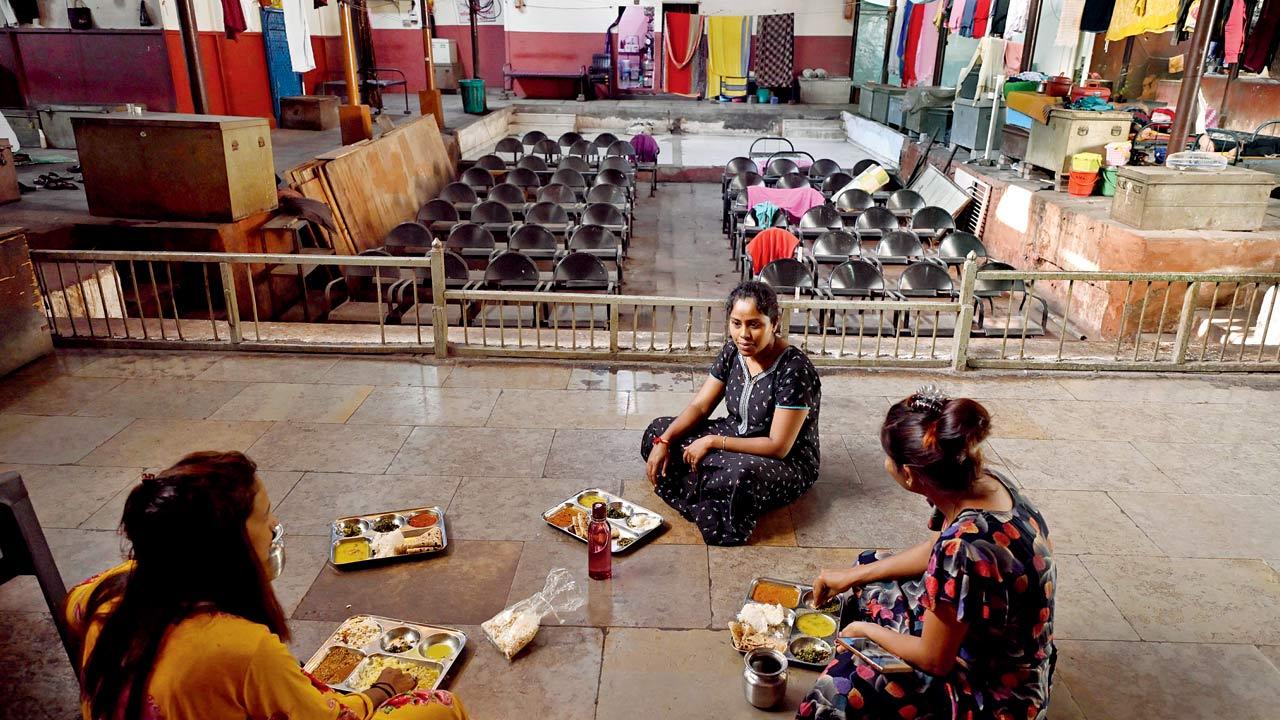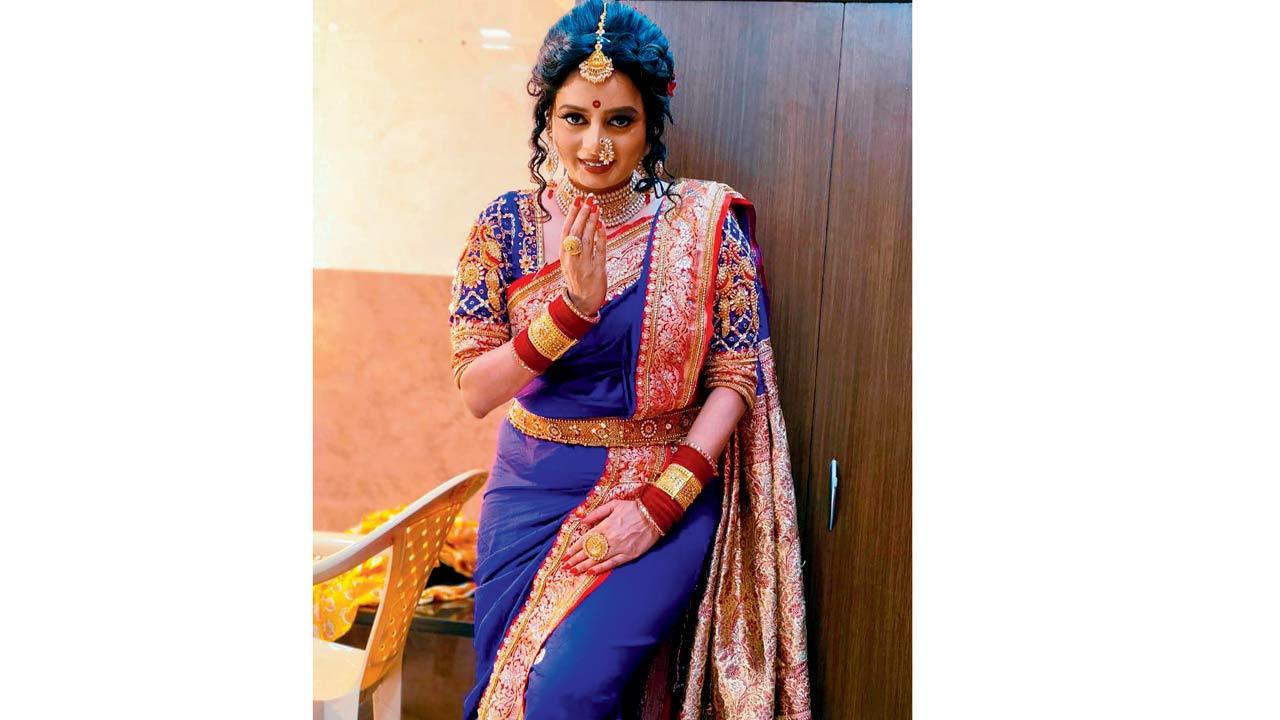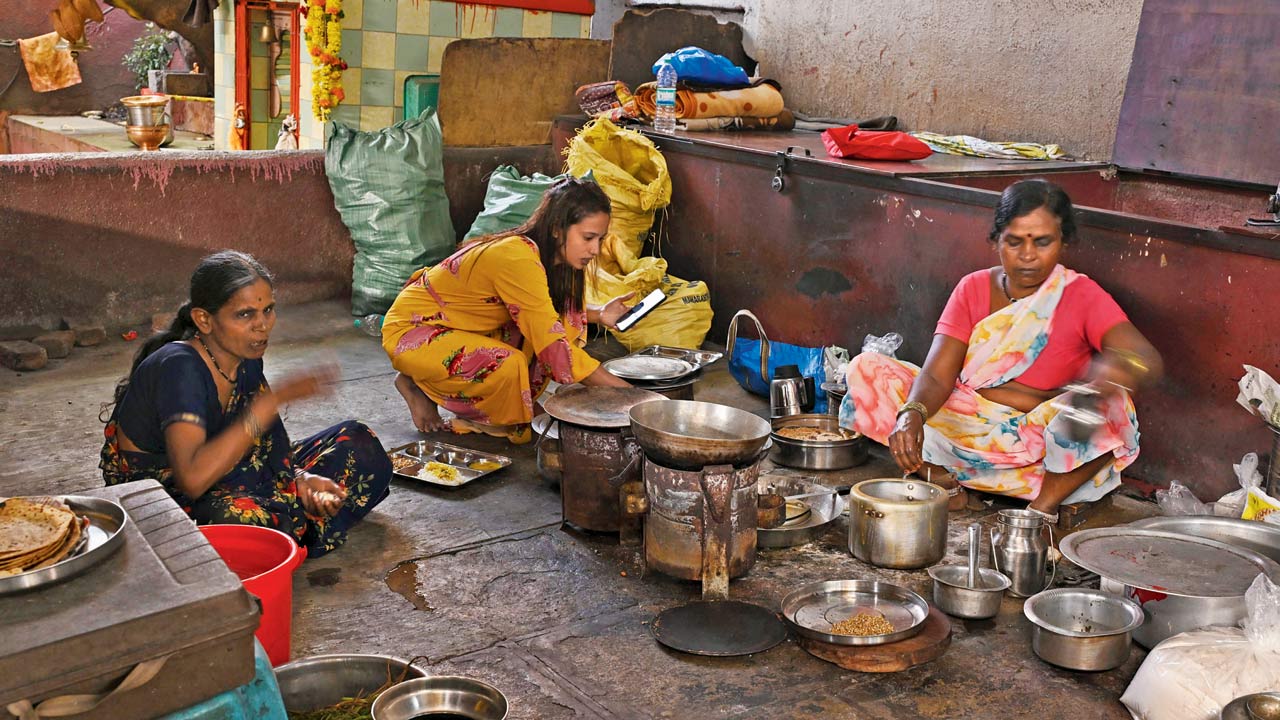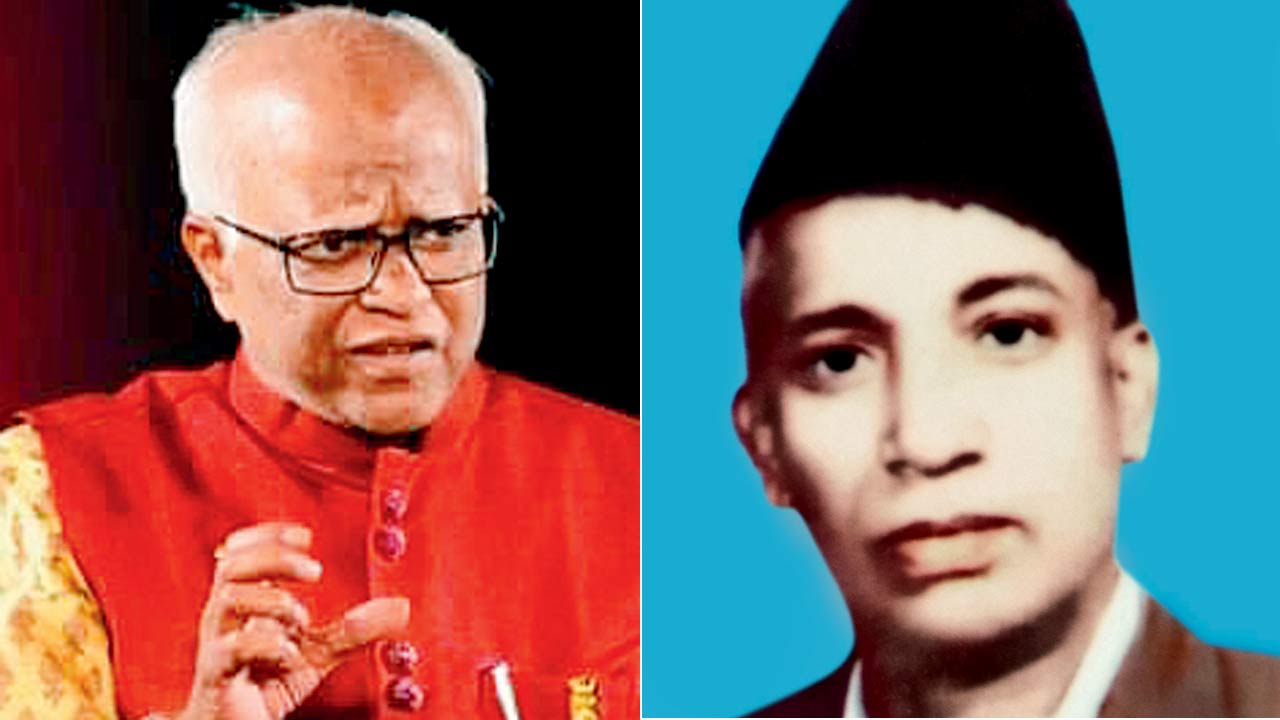They don’t have homes, jobs or land, and now their livelihood has been snatched by imposters hosting ‘dance bars’ under the garb of lavani, say traditional performers

Rajendra Javale plays the dholki while his troupe members sing at Pune’s Aryabhushan Tamasha Theatre. This is not just where they perform and rehearse but also where they sleep, eat and dry their laundry. Pics/Ashish Raje
It has been an uphill battle over decades for tamasha performers to win public respect and recognition of lavani as a folk art form rather than a low-brow, bawdy dance show. For the Kolhati community—which is among a handful of clans that have traditionally performed the dance form, particularly baithaki chi lavani (seated performance)—their art is all they have. As a nomadic community, they have neither homes nor land, and they travel all year from theatre to theatre across Maharashtra, performing for dwindling audiences and shrinking income.
ADVERTISEMENT
The crowds—and the money—are instead going to the new-age “DJ lavani” shows, where the performers’ nine-yard sarees are replaced by six-yard sarees, and the traditional melodies played on dholki, harmonium, tabla, and tuntuni (a single-string instrument) are replaced by a DJ set blaring Bollywood item numbers. While traditional lavani is known for its mildly erotic undertones, the DJ lavani shows have been accused of outright vulgarity, drawing large crowds comprising mostly men. Thanks to this, the real lavani performers are being robbed of not just their audiences, but also their hard-won respectability, says the Kolhati community.
Community members recently met Chief Minister Eknath Shinde and submitted a charter of demands, the chief among them being an immediate ban on such DJ lavani performances. But with no assurances from the CM, the 33,000-strong Kolhati community spread across Maharashtra have decided to make a show of strength at the Mantralaya once the state assembly elections come to an end.

Sunday mid-day visited one of the state’s oldest existing lavani theatre, Aryabhushan Tamasha Theatre in Pune for a closer look at the community’s way of life and their woes. The 91-year-old theatre has given a platform to many well-known lavani dancers and Marathi film actors over the years.
There, we meet Rajendra Javale, who has sung and played the harmonium and dholki in lavani productions for over four decades. “For generations, our communities [Bhatu Kolhati and Dombari Kolhati] have been subjected to abuse and humiliation, by not only those in power but even society at large,” he says, adding, “Our ancestors travelled from one place to another to perform traditional lavani and tamasha, and would seldom get paid for their talent. To this day, we do not own houses or farm land. Banks do not give us loans since we have nothing to offer as collateral. Nor do we receive medical aid.”
While the perception around lavani has improved since 1948, when the state government had banned it on the ground that it was too obscene for public entertainment, stigma still follows the community. “The worst part is even after our children get educated and become graduates, they remain jobless [due to the stigma]. Enough is enough, we won’t take it [injustice] anymore,” says Javale.
 Pramila Lodgekar, lavani performer
Pramila Lodgekar, lavani performer
It doesn’t help that people confuse the folk art form with the obscenity seen at DJ lavani shows. “DJ lavani has become a desi form of dance bars in rural parts of Maharashtra,” says Shivaji Javlikar, executive chairman of the Maharashtra Loknatya Sanskruti Kalakar Sangathan (MLSKS), an association formed by traditional lavani troupe members to better voice their concerns. “Once the election is over and the state government is formed, we will approach the cultural minister and press our charter of demands,” he adds.
As DJ lavani pulls more viewers away, tickets sales for the traditional form are drying up. For a three-hour traditional show, each of the 11 members of the troupe (six dancers, a singer and four instrument players) earn a paltry R50 or R100. Each ticket costs Rs 50, but barely five to six people attend the show on average.
Pramila Lodgekar, 36, a well-known lavani performer who has won many accolades, says, “I have been dancing for almost twenty years, and have witnessed the grim situation of traditional lavani troupes first-hand. DJ lavani is gradually overtaking the traditional form. Our audience numbers have fallen drastically, and it’s the opposite at DJ lavani shows, where the dancers are exploited and the money flows.”
Like many professions, lavani too has taken a hit since the COVID-19 pandemic, says the Kolhati performer from Latur. “In the last few years, our financial situation has gone from bad to worse. We can feed our family only when we perform. On days we do not have any audience [for our regular shows], we host private performances baithaki chi lavani (private performance) in a room,” says Lodgekar, adding that the troupe earns Rs 2,000 to Rs 3,000 from these private sessions, a portion of which also has to be paid to the theatre owner.
 Women from the troupe cook for all the members, each of whom contributes Rs 1,500 per month for the meals
Women from the troupe cook for all the members, each of whom contributes Rs 1,500 per month for the meals
Lavani, which once had royal patronage in Maharashtra, now looks to the government for more support. “My last performance was in February at an event organised by the Maharashtra government in Solapur. That was the last government-supported programme. We wait for such mega events, as we get around Rs 60,000 for a one- or two-hour-long show. This money is then distributed among the troupe members,” says Lodgekar.
Dwindling ticket sales are a threat to the existence of not just the troupes but also the handful of theatres that still provide them with a platform and safe haven. “Today, Maharashtra has 80-odd live lavani performance theatres and among the four oldest—Jalsa theatre in Kolhapur, New Hanuman theatre in Lalbaug, Mumbai, Gungroo theatre in Solapur and Aryabhushan in Pune—only the last is functional,” says Dhondiram Javale, MLSKS President.
Of the remaining venues, 32 theatres across Ahmednagar, Parbhani, Latur, Osmanabad and the interiors of Pune feature mostly DJ lavanis, he adds. Some theatres prevent intervention by the authorities by starting off with a traditional lavani performance for the initial few minutes and then switching to the more bawdy DJ version, claims Dhondiram. “DJ lavani shows are not only exploiting our art form, but also their own dancers. The audience at such shows dictate their choice of songs and the more influential among them even demand closer proximity with the dancers,” he alleges.
 Dr Prakash Khadnge and Ahmedshet Tambe
Dr Prakash Khadnge and Ahmedshet Tambe
MLSKS now has more than 5,000 Kolhati members from all over the state fighting to keep their tradition alive, says Dhondiram. “Aryabhushan theatre continues to feature traditional baithaki chi lavani, but even that may not be for long, as the owners are struggling to keep the doors open with no income flow.”
Noor Tambe, one of the eight siblings who are the second-generation owners of Aryabhushan theatre, admits they have discussed shutting it down, although they remain divided on the subject.
“In 1933, our father Ahmedshet Tambe leased the 12,000-sq-foot plot with the intention to promote Maharashtra’s traditional folk dance and provide a platform to young talent. We continue to pay the R500 lease to the land owners,” says Tambe.
 The rundown condition of Aryabhushan theatre, one of the oldest tamasha venues still in existence, is telling of the fall in lavani’s popularity
The rundown condition of Aryabhushan theatre, one of the oldest tamasha venues still in existence, is telling of the fall in lavani’s popularity
While a few of his family members have expressed interest in keeping the shows running, the future seems bleak. Tambe has appealed to the government to take over the theatre to preserve the original art form.
For the Kolhati lavani performers, this could well be the death knell. For the nomadic troupes, theatres like Aryabhushan are not just performance venues, but a temporary home where they live and practise their craft for a year, before moving on to the next town. “If this theatre shuts down, our community will be on the streets. We appeal to the government to consider our charter of demands before it is too late,” says Dhondiram.
“Lavani has taken Maharashtra lok natya to audiences across India and abroad, but neither the art form nor the artists received recognition. It is now up to the state government to accept our plea, or else both will vanish in next few years,” he adds.
Rs 100
Each troupe member’s earning from a 3-hour show
Their demands
. Mandatory health insurance for performers and dependants
. Free housing and land for cultivation for all performers under Modi Awas Gharkul Yojana
. Dropping the minimum age from 50 to 40 years for the state’s R5,000 monthly honorarium for senior artists
. A state-run tamasha training centre in Pune
. An annual award with three categories—an award named after lavani singer Padma Shri Yamunabai Waikar for the best lavani troupe; an award for best woman dancer, named after renowned lavani artist Roshanbai Satarkar; and a best tamasha troupe prize named in honour of National Film Award-winning choreographer Laxmibai Kolhapurkar.
What is lavani?
“Lavani has a great tradition in Maharashtra. It is not just about romantic and erotic expressions,” says Prakash Khandge, founder of Lok Kala Academy (performing folk arts department) of Mumbai University. “Lavani has its roots in gavlan [spiritual poetry] penned by saints like Dnyaneshwar, Namdeo, Tukaram, Eknath between the 13th and 18th centuries. It hit its zenith in the 19th century, during the reign of Bajirao Peshwa. In the early 20th century, traditional tamasha was of two types—Dholki Fadacha [song, dance and drama] and Sangeet Bari [a more intimate set, with more dance and music than drama,” he adds.
“Lavani once had royal patronage; today it has been overpowered by an adulterated version—DJ lavani. Performers dancing to item songs played by DJs may be more popular among younger crowds in rural Maharashtra, but this has degraded the purity of traditional lavani, compromising on quality, costumes and even the performances,” says Khandge, who is also a member of the Sangeet Natak Akademi.
Also Read: Maharashtra to celebrate October 3 as 'Marathi Classical Language Pride Day'
 Subscribe today by clicking the link and stay updated with the latest news!" Click here!
Subscribe today by clicking the link and stay updated with the latest news!" Click here!







